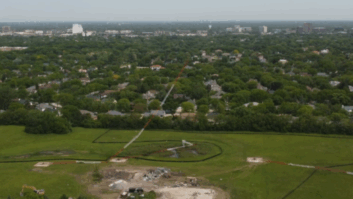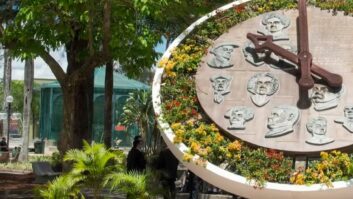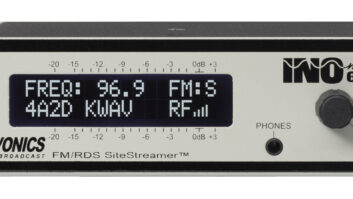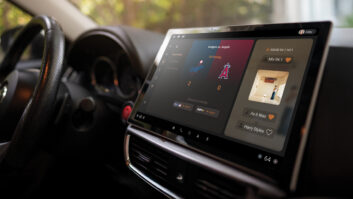WXPN procures a place in Philly
Sep 1, 2005 12:00 PM, By Jay Goldman
The control rooms have similar layouts. This is control room B.
The news studio looks into the control rooms and serves as an interview space as well.
Maia Sharp performs with her band in the performance studio.
The technical operations center houses six racks.
Studiohub was used for all the equipment interconnections.
Old location.
New location.
After operating for more than 30 years out of a Victorian mansion built in 1875, WXPN, the radio station of the University of Pennsylvania, moved into a new, custom-built facility in September 2004. After searching for the right location and building for more than three years, Vinnie Curren, then the general manager of WXPN, located the Hajoca Building. Located between the edge of the University of Pennsylvania campus and center city Philadelphia, this building appeared to be the ideal spot for the radio station as well as for World Caf� Live, a for-profit performance venue and restaurant that attracts musical performances and artists often heard on WXPN’s AAA format.
The performance venues, an upstairs cafe that seats about 100 and World Cafe Live Downstairs, which seats about 300 in dinner-theater style or in a 700-seat theater, are both wired into the radio station’s technical operations center, allowing live concerts on the air or for multi-track recording for later broadcast. This building also gives us the space to combine our on-air and production facilities with our business office, membership and underwriting departments, which had been operating out of another building several blocks away.
The concept of the partnership between WXPN and World Cafe Live was the brainchild of Hal Real, president of Real Entertainment. He approached Curren about six years ago with the idea.
Finding a home
Several locations were considered before deciding on the Hajoca building, a former plumbing warehouse that had been gutted, leaving a 100′ x 200′ shell. The building was stripped to the bare walls, including excavating the floor, and then rebuilt from the ground up. The WXPN studios occupy half of the lower level, making soundproofing easier, because the studio concrete floor is poured right on ground level. The concrete slab is cut between studio walls to eliminate transmission of vibration and all the studio walls are double or triple thick. The performance studio has a floating floor and is totally a room-in-a-room.
One of the challenges faced during the construction was providing enough sound isolation between the north wall of the performance studio and the mechanical room housing the air-handling units for the entire building on the other side of the wall. With a triple-thick block wall and spring/shock mounted air-handling units, there are no noise transmission problems.
Another challenge arose when it came time to relocate our NPR satellite dish. Although the roof of the building gave us a perfect, unobstructed view of the southern sky, the trussed roof construction did not allow for the weight and wind load requirements of a 3.8 meter C-band dish. There wasn’t any place to mount the dish on the ground next to the building, so we decided to place it on the roof of the University of Pennsylvania Skating Rink across the street, and connect to the studio using Force Fiber L-Band-to-fiber converters and fiber optic cable run under the street.
The action plan
I designed the radio station facility using the Radio Systems CAT-5 Studio Hub wiring system. This allows flexibility for configuring signal routing, as well as routing audio to the offices upstairs using the Ethernet infrastructure already in place. The console and routing system is a Logitek engine and worksurface system. We already had one Logitek Roc-10 worksurface and engine, which we installed when we upgraded the on-air control room in the old building in 2002. I expanded on this system and now we have four DJ-style control rooms, three using Numix worksurfaces and one using the Roc-10 worksurface brought over from the old facility, one news studio and control room using a Remora 4 worksurface and one 200 square-foot, bare-bones studio used for small groups that play live on the air.
There is also a 900 square-foot performance studio and an accompanying multitrack control room. Multitrack mixing is possible with a Yamaha PM1-D digital multitrack console, as well as a Yamaha O2R brought over from the old building. Multitrack sessions are recorded to Tascam MX2424 hard drive recorders with backups to DVD.
The technical operation center has six equipment racks, housing our RCS automation system, several file servers, a Logitek engine that serves as a central router, our TFT 911 EAS system, NPR demods, RF distribution equipment, master clock system, the I/O and central processing for the Yamaha PM-1D mixing desk, as well as a Rariton Paragon 16 port KVM/monitor workstation and QC equipment, including a Dorrough audio test set and an off-air receiver. The technical operations center (TOC) also houses our Ethernet router and patching and Nortel digital telephone KSU. The telephone system is wired with all ports on RJ45 patch panels, which makes moving telephones from one location to another extremely easy, without having to move wires on punch blocks.
The studio installation was turn-keyed by Radio Systems, who handled all the equipment ordering and delivery, system design and documentation as well as installation, testing and training. The studio furniture was designed and installed by Studio Technology.
We kept our existing Harris CD Link 950MHz STL, which is on the roof of a 26-story student residence next door to our old building and shoots to our tower, which is about five miles away. After trying unsuccessfully to use 5.8GHz spread spectrum microwave to make the one-mile jump from the new building, we settled on a fiber-optic link, using Fibox equipment. The microwave path we were attempting looked good, but there was too much RFI getting across campus. We also have a transmitter in Harrisburg, PA, which is fed by T-1, using a Musicam Prima LT and Adtran terminal adapter.
All the equipment racks in the TOC and critical on-air equipment have local UPSs and we have a 75kVA diesel generator and automatic transfer switch, which powers the studio complex as well as a 1.5-ton backup air conditioning unit that cools TOC and the on-air control room. We gave it a real world test last month when an underground power cable failed and the building lost power at about 4 a.m. The generator took over and kept us on the air for about six hours until power was restored.
After being in the new facility for 11 months now, I don’t think I would do much differently. We’ve already produced many world-class recordings from our performance space. Workflow is far better than ever before and the bands that come to our studio no longer have to carry their equipment up three flights of stairs.
Goldman is chief engineer of WXPN, Philadelphia.
Equipment list
On Air
Air Corp 500PH
Denon DN961FA CD
Electro-Voice RE-20
Enberg BA12 system
Logitek Audio Engines with Numix, ROC-10 and Remora 4 worksurfaces
Radio Systems CT2002 system w/GPS
Raritan Paragon
RCS Master Control v15
Studio Hub
Studio Technology custom cabinets
Tannoy Reveal
Telos One + One, One x Six, Zephyr Xstream
TFT 911
Recording Studio
Countryman Type 85 direct boxes
Dell Poweredge 2650 & 4400
Furman HDS16
Genelec 1031, Genelec 8030a
HHB Burnit Plus
JBL EON15P
SAW32
Sony PCM R700
Syntrillium Cool Edit Pro
Tascam MX2424SE
Whirlwind 24-channel snake/splitter
Yamaha NS10, PM-1D, O2R
Processors
Avalon AD 2022 mic preamp
Universal Audio 1176N
UREI LA4
Mics
AKG C414B, D112
Crown GLM100
Neumann KM 184, TLM 103
Sennheiser e604
Shure Beta 58, SM81






